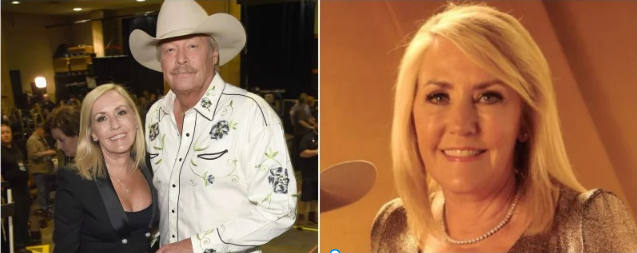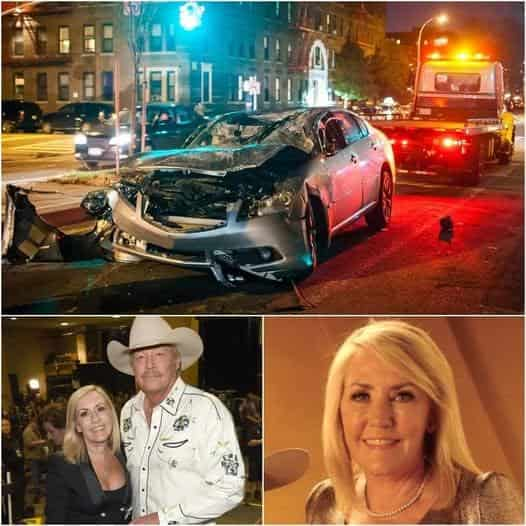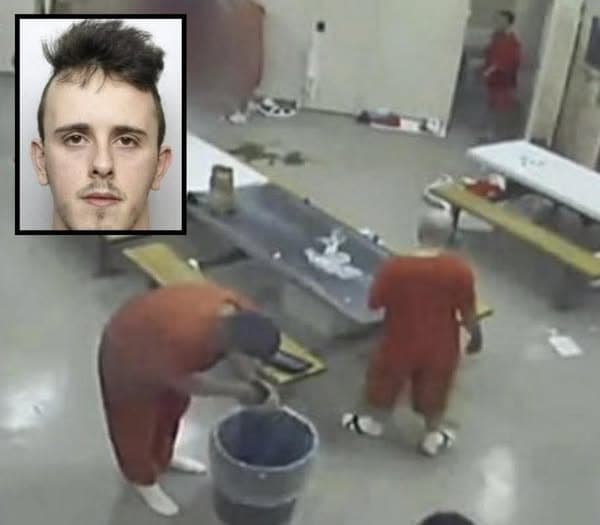The accident took place on a busy street in Houston, where pedestrians were making their way across the road when the driver failed to heed the red light. According to witnesses, the vehicle was seen speeding through the intersection, and the driver appeared distracted. It was later revealed that the driver was using a mobile phone at the time of the accident, a practice that continues to be a leading cause of traffic accidents across the United States.
The victim, who was walking with her family, was immediately rushed to a nearby hospital after the collision. Emergency responders worked quickly to stabilize her before she was taken to the facility. In the chaotic moments following the accident, rescue teams were unaware of the woman’s identity. However, upon arriving at the hospital, it was revealed that the woman was Denise Jackson, the wife of Alan Jackson, a country music icon known for hits like “Chattahoochee” and “Don’t Rock the Jukebox.”
The news sent shockwaves through both the public and the country music community. Alan Jackson, who is well-known for his music and lengthy career, has not yet made a public statement regarding the incident. However, his fans and the broader country music community have quickly expressed their support and concern for the Jackson family during this difficult time.
Denise Jackson has long been a private figure, despite being married to one of country music’s most beloved stars. The couple has been married for over 40 years, and Denise has been a supportive partner throughout Alan’s career. While Alan Jackson has built a reputation as a humble and down-to-earth figure, Denise has largely remained out of the spotlight, dedicating much of her time to supporting her family and quietly supporting her husband’s endeavors.

The accident has raised important questions about distracted driving, especially in the age of smartphones. According to the National Highway Traffic Safety Administration (NHTSA), distracted driving remains one of the leading causes of traffic accidents in the United States. Texting and using mobile phones while driving have been linked to numerous crashes, and despite widespread awareness campaigns, the problem continues to be a serious issue. In this instance, the driver’s use of a phone while behind the wheel has directly led to the collision, with tragic consequences for the victim and her family.
As of now, the driver involved in the accident has been identified by law enforcement, but further details regarding their identity and any potential charges have not been made public. Investigations are ongoing, and authorities are working to determine whether the driver was under the influence of any substances or whether other factors played a role in the incident.
The Jackson family is known to have a strong, tight-knit bond, and many are hoping for Denise’s swift recovery. Fans have flooded social media with messages of support for both Alan and Denise, wishing her a full recovery and hoping that justice is served for those affected by the accident. Alan Jackson, who has been a beloved figure in the country music world for decades, is undoubtedly facing an incredibly difficult time. Fans and the public alike are holding out hope that Denise Jackson will pull through this devastating ordeal.
As investigations continue and more information becomes available, one thing is clear: this tragic accident has put a spotlight on the dangers of distracted driving. While the Jackson family continues to deal with the emotional and physical toll of the incident, it is also a reminder of how crucial it is for drivers to remain focused on the road and avoid any distractions, including the use of mobile phones.
In the coming days, more details about Denise Jackson’s condition are expected to be released. For now, the Jackson family is asking for privacy as they navigate this challenging and heart-wrenching time. Fans and loved ones around the world are hoping for a positive outcome and sending their thoughts and prayers to Denise Jackson for a swift recovery.
The U.S. military conducted air strikes on Iran’s nuclear facilities in Fordow, Natanz and Isfahan on Sunday morning local time, President Trump announced.
Trump’s decision to intervene directly in support of Israel’s effort to dismantle Iran’s nuclear program marks a historic escalation in the Middle East.
It’s an intervention fraught with risks and uncertainty — one that Trump and many of his predecessors had sought to avoid, including through diplomacy with Iran.
The attack, which came on the ninth night of the unprecedented war between Israel and Iran, could provoke retaliation from Tehran against U.S. troops and military installations across the region.
An Israeli official said Israel was notified by the Trump administration in advance of the U.S. strikes in Iran.
What they’re saying: “We have completed our very successful attack on the three Nuclear sites in Iran, including Fordow, Natanz, and Esfahan. All planes are now outside of Iran air space,” Trump wrote on his Truth Social account.
“A full payload of BOMBS was dropped on the primary site, Fordow,” he continued, referring to Iran’s most fortified uranium enrichment facility.
“There is not another military in the World that could have done this. NOW IS THE TIME FOR PEACE!” In the days leading up to the strike, Trump and his team became increasingly convinced that diplomacy had run its course — and that military action would be necessary to eliminate Iran’s nuclear program.
The president publicly announced on Thursday that he would make a decision “in the next two weeks” to give Iran a final chance to negotiate, but preparations for a strike accelerated over the weekend.
Multiple B-2 stealth bombers — capable of carrying 30,000-pound “bunker-busters” — were detected heading west across the Pacific on Saturday, as speculation mounted that the U.S. would strike Fordow.
Trump had publicly questioned Israel’s capacity to take out the underground facility on its own, saying Friday: “They can break through a little section, but they can’t go down very deep.”
Man Arrested After Climbing White House Fence, Secret Service Responds Swiftly
Washington, D.C. – A man was arrested by the U.S. Secret Service on Monday after he climbed over the outer security fence along the South Grounds of the White House.
The incident occurred in the late afternoon, drawing an immediate response from Secret Service personnel, including tactical officers, K-9 units, and rooftop snipers. According to eyewitnesses, the individual, dressed in black, approached the fence, muttered something under his breath, and proceeded to scale the barrier before becoming stuck on the anti-climb spikes at the top.
Video footage captured by a tourist nearby shows agents quickly surrounding the area and pulling the man down to take him into custody without further resistance. Authorities have not released the suspect’s identity or stated a clear motive.
“This was an isolated incident, and the individual was apprehended within seconds,” a Secret Service spokesperson confirmed in a statement. “At no time was the President or White House staff in danger.”
No weapons were found on the suspect, and no injuries were reported. An internal investigation is underway, and charges may be filed depending on the outcome.
Security around the White House remains tight, especially as the 2024 election season has drawn increased public attention and demonstrations near the premises.
Liam Deane was found dead just a month after being imprisoned for the murder of his daughter.Deane was allegedly killed by prisoner John Westland, who appeared in court following the discovery of Deane’s body.
Deane was charged and jailed after admitting to punching and shaking his 2-day-old daughter Luna because she “would not stop crying.” Luna died three days later as a result of brain injuries. He was sentenced to life in prison for the murder.
“[Deane] said he was responsible for all of the injuries that she had suffered and he said that Luna had not settled down and he lost control,”the prosecutor said in court at the time, Mirror reported.
In my submission there is simply no explanation for the defendant’s [behavior],” Richard Wright, who represented Deane in court in Leeds, England, said at the time.
On July 24, 2024, President Joe Biden emotionally announced from the Oval Office that he was withdrawing from the 2024 presidential race, citing concerns about his age and health. He stressed that his decision was made for the good of the country and the Democratic Party, saying, “The defense of democracy is more important than any title.”
Biden reflected on his journey from humble beginnings in Scranton to becoming president, highlighting the significance of his role. He strongly endorsed Vice President Kamala Harris as the Democratic nominee, urging the nation to support her as the first woman of color to lead a major party ticket.
The announcement received mixed reactions but showed Biden’s commitment to putting the nation first. Afterward, he continued his presidential duties, focusing on policies and diplomacy, determined to serve until the end of his term while the country prepared for a political transition.
Country music legend Alan Jackson collapsed during a live performance in Georgia last night and was rushed to the hospital. The 66-year-old singer struggled with balance before falling, leaving fans and the music community deeply concerned. His family confirmed his hospitalization but asked for privacy, while fans and fellow musicians shared support using the hashtag #PrayForAlan.
Jackson, a Georgia native and Country Music Hall of Fame member, has had a career spanning over 30 years with hits like “Chattahoochee” and “Where Were You (When the World Stopped Turning).” He has been open about living with Charcot-Marie-Tooth disease, a nerve condition affecting mobility, yet he continued to tour despite the challenges.
Medical experts say the disease weakens muscles over time, making performing harder. Last night’s incident raises questions about his future on the road. Fans and artists alike are sending prayers and memories, hoping for his quick recovery. Alan Jackson’s impact on country music is undeniable, and his fans eagerly await updates on his condition.
Charli Worgan and Her Family’s Inspiring Journey
Charli Worgan and her husband Cullen, both living in Sydney, each have a different form of dwarfism. Instead of being asked when they’d have children, they were often asked why. Despite public scrutiny and medical risks, the couple now have three beautiful children.
Due to their genetic conditions, each pregnancy carried serious risks. Their children could inherit one parent’s form of dwarfism, be of average height, or inherit both conditions—something doctors say would be fatal at birth. During her third pregnancy, Charli had to undergo painful CVS testing to determine the baby’s condition.

She shared her emotional journey on Instagram, where she now has over 300,000 followers. Charli has faced criticism for having children, but she’s been open about the difficult choices involved and advocates for kindness and understanding.

In early 2021, her son Rip was born healthy, joining his sisters Tilba and Tully. Charli uses her platform to show that, despite the challenges, her parenting journey is just like everyone else’s—full of love, struggle, and joy.
Her story is an inspiration to many and a powerful reminder that all families deserve respect.

If your partner always asks you to do it from behind, it can lead to a mix of curiosity and intrigue. This video delves deep into the reasons behind this preference and explores the psychology of intimacy associated with it. Is it simply a matter of physical pleasure, or is there a deeper emotional connection? We’ll uncover insights from experts and share personal stories that shine a light on this common request. Whether you’re open to exploring new dimensions of your relationship or just seeking to understand your partner’s desires better, this video promises to offer valuable perspectives. Let’s dive in!
Jennifer Lopez has always been at the forefront of entertainment and fashion. Whether she’s performing on stage, attending a high-profile event, or simply enjoying a night out, she never fails to make a statement with her wardrobe choices.
Recently, Lopez stepped out in a striking leather dress that turned heads and sparked lively discussions among fans, media outlets, and fashion enthusiasts around the globe. While the dress itself was noteworthy, it was the way she carried it—with unshakable confidence and flawless poise—that truly stole the show.In a world where trends come and go in the blink of an eye, Jennifer Lopez remains one of the few celebrities capable of consistently capturing public attention for her sartorial flair. Her latest appearance in a figure-hugging leather ensemble was no exception. From the moment she arrived at her evening destination, cameras captured every detail: the gleaming finish of the leather, the meticulous tailoring that accentuated her famed curves, and the harmonious way she paired her outfit with subtle yet impactful accessories.
The result was a look that blended modern edge with classic sophistication, reminding everyone that Lopez is more than just a singer and actress—she is a bona fide style icon. Yet, Lopez’s fashion influence extends far beyond the immediate reaction to any single outfit. Over the years, she has displayed an incredible range of style, transitioning seamlessly from glamorous red carpet gowns to casual streetwear, always with an undeniably personal touch.
Her willingness to embrace bold designs and unexpected fabric choices has established her as a trendsetter rather than a follower. This latest leather dress might be a nod to the edgier side of her style persona, but it also highlights her consistent approach to fashion: fearlessness, polished execution, and a dash of adventure.  1. The Power of Confidence
1. The Power of Confidence
One of the most compelling aspects of Jennifer Lopez’s style is her confidence. Even before critics or fans weigh in, she exudes an aura of self-assuredness that seems to communicate, “I know who I am, and I’m proud of it.” This quality is evident in nearly every public appearance she makes, and it’s especially visible when she opts for pieces that challenge conventional red carpet or nightlife attire. A sleek leather dress can be tricky to pull off—too tight, and it restricts movement; too loose, and it loses its form; worn without the right accessories, and it can feel incomplete. Lopez, however, demonstrated a masterclass in wearing leather: the cut flattered her silhouette, the color (classic black) provided a timeless backdrop, and every element of her look supported her inherent poise.
Confidence is more than just standing tall—it’s also about being comfortable in your own skin. Lopez’s posture, her smile, and her evident enjoyment of the moment all contributed to a sense that she was utterly at ease. This self-possession is a hallmark of her brand, reflecting years of performing onstage and walking red carpets. Regardless of whether she is launching a new project or simply celebrating a personal milestone, Lopez’s style choices encapsulate self-belief, ambition, and a desire to experiment rather than stick to the safe and familiar.  2. The Art of Accessorizing
2. The Art of Accessorizing
In addition to the dress itself, Lopez’s accessories garnered praise. While full details weren’t widely publicized, photos of her out and about suggest she understands the importance of balanced styling. She chose statement jewelry that complemented the leather’s edgy vibe without overshadowing it, possibly a pair of eye-catching earrings or a delicate necklace that drew attention to her neckline. Instead of overloading on sparkle, she seems to have embraced the “less is more” mantra, allowing the dress to remain the focal point.
Her choice of footwear, although subtle in many shots, played a critical role in the ensemble’s overall impact. A pair of sleek heels elongated her frame and added an additional layer of elegance to what might otherwise be perceived as a purely edgy outfit. Such attention to detail underscores Lopez’s reputation for thoroughly planning her outfits—from earrings to shoes—in a way that is coherent and fashion-forward.
3. Makeup and Hair as the Finishing
TouchPart of the reason Lopez’s appearance in a leather dress resonated so strongly is her signature approach to beauty. Known for her glowing complexion—often referred to as the “JLo glow”—she uses makeup to enhance, rather than mask, her natural features.
A polished, luminous makeup look can serve as the ideal counterpoint to the boldness of leather fabric. Although she is recognized for her love of dramatic eye makeup on stage, for a night out, it’s likely she opted for well-defined eyes, highlighted cheekbones, and a nude or soft lip color. This kind of beauty routine walks the line between glamorous and approachable—perfect for turning heads without overwhelming the senses.
Similarly, her hairstyle added another dimension to the ensemble. Whether she went for loose waves cascading over her shoulders or a sleek updo that highlights her bone structure, Lopez never neglects the power of hair in completing a look. A fresh, modern hairstyle can transform an outfit from a mere garment into a cohesive style statement. By selecting a look that harmonized with her bold dress, she demonstrated her knack for consistency and flair.  4. Setting Social Media Alight
4. Setting Social Media Alight
Unsurprisingly, social media lit up the moment photos of Jennifer Lopez in her leather dress surfaced. Platforms such as Instagram, Twitter, and TikTok served as virtual watercoolers where fans and fashion enthusiasts dissected every aspect of her outfit. From the cut of the dress to the choice of accessories and the angle of photos capturing her confidence, there was no shortage of excitement—and praise.Commenters applauded her age-defying presence, her consistent reinvention, and her role as a leading example of self-expression.
Many also celebrated her message of body positivity, pointing out that wearing a figure-hugging leather dress in the spotlight sends a clear statement: women can continue to explore and celebrate fashion as they grow older, without feeling obliged to follow rigid or outdated “rules.” In an industry that often prizes youth and novelty, Lopez’s persistent ability to stun in new ways has become a beacon of empowerment, reminding us that style transcends age and expectation.
5. The Enduring Influence of Jennifer Lopez
Lopez’s ability to command attention in the fashion realm can be traced back to iconic moments, such as her memorable turn in a green Versace gown at the 2000 Grammy Awards—a moment so influential it sparked discussions about the future of image search technology. Over two decades later, she revisited that iconic dress on a runway, proving she continues to hold sway over public imagination.
Her longstanding impact is partly due to her versatility: she moves seamlessly between music, film, television, and entrepreneurial ventures. Whether launching a skincare line, producing a new project, or performing in a highly anticipated show, her name remains synonymous with creativity, drive, and a refusal to be confined by a single label.
This spirit permeates her fashion choices as well, embodying a willingness to push boundaries while staying undeniably true to her personal brand.
6. Empowerment Through Fashion
Perhaps most notably, Jennifer Lopez’s style reflects a commitment to empowering herself and others. This commitment becomes apparent not only in her professional endeavors—such as advocating for women in the music industry or supporting emerging Latina artists—but also in the ways she chooses to present herself to the world.
A leather dress might simply look like a bold choice for a night out, but beneath the surface lies a deeper implication: fashion can be a tool for personal expression, a platform to challenge societal norms, and an opportunity to encourage people of all backgrounds to feel confident in who they are.
Her stance is refreshingly candid in interviews: time and again, she has voiced how she doesn’t believe in letting criticism or external expectations dictate her decisions.
This mindset resonates strongly in her outfits, which exude ownership of her body, her talents, and her narrative. Indeed, each public appearance solidifies Lopez’s message that self-assurance is integral to both personal and professional success—no matter the stage of life.  7. Reinventing Beauty Standards
7. Reinventing Beauty Standards
Hollywood, and the entertainment world at large, often broadcasts narrow definitions of beauty and style. Jennifer Lopez’s leather dress moment serves as a counterexample, showcasing that success, glamour, and daring fashion are achievable at any life stage.
The singer, actress, and entrepreneur continually challenges the notion that certain clothing items or silhouettes become “off-limits” after a particular birthday. She navigates an industry where scrutiny can be relentless—yet she repeatedly demonstrates that dressing for oneself is both liberating and admirable.
Each high-profile event or casual outing with Lopez at the center reveals another facet of this ongoing reinvention of beauty standards. By eschewing boundaries set by conventional wisdom or the fashion police, she opens the door for countless individuals—especially women—to follow suit. Her example resonates in social media conversations, where fans share their own leather looks or post about feeling inspired to try something new.
In this sense, Lopez’s influence transcends passive admiration and becomes an active call to self-expression.
8. Looking Ahead: What’s Next?
Even as this particular fashion moment garners praise, fans can’t help but wonder what Jennifer Lopez might try next. She has built a career and personal brand on staying ahead of the curve, surprising audiences, and evolving her aesthetic.
Will she opt for more bold leather numbers in the future, or pivot to something entirely different? Whether it’s a throwback nod to earlier fashion eras, a test of futuristic materials, or even a playful mishmash of street style and haute couture, it’s safe to say that her fans and the wider public will be watching—and anticipating—her next sartorial move.
Yet beyond the specifics of any single outfit, Lopez’s influence carries a broader lesson: true style stems from authenticity, self-confidence, and the willingness to take risks. She is a reminder that the most compelling fashion icons are those who remain rooted in who they are, unafraid to step outside the box. From her earliest days in the spotlight to now, her trajectory has illustrated that there’s power in forging one’s own path, both on and off the red carpet.  Conclusion
Conclusion
Jennifer Lopez’s recent night out in a sleek leather dress is more than just another celebrity fashion highlight—it’s a glimpse into how she continues to meld empowerment and style in equal measure. Each appearance, whether at a premier event or a private celebration, reaffirms her status as a changemaker in the world of fashion and entertainment.
By confidently sporting a figure-hugging leather piece and showing the world how effortless it can look, she exemplifies the notion that style transcends age, body shape, and fleeting trends.Her enduring relevance in the public eye underscores a simple yet powerful reality: Jennifer Lopez’s wardrobe choices matter because they reflect a deeper narrative of fearlessness, individuality, and evolution.
Fans will no doubt continue to emulate her looks, discuss her outfits on social media, and find inspiration in her approach to embracing life’s possibilities. Indeed, in a single night out, dressed in a single leather dress, Jennifer Lopez did what she’s always done best—captivate, impress, and remind everyone watching that true style is as much about attitude as it is about fabric and design.
Understanding Uterus Didelphys: The Journey of a Unique Individual
In a world where most people might think of the human anatomy as a straightforward matter of one vagina, one uterus, and one cervix, there are exceptional cases that defy this norm. One such case is that of Evelyn, an Australian woman who was born with a rare medical condition known as uterus didelphys. This condition, characterized by the presence of two uteri, two cervixes, and two vaginas, has profoundly shaped her life experiences, particularly regarding her sexuality and her path to motherhood. The journey of understanding and accepting this condition offers significant insights into the complexities of human anatomy.

A Candid Introduction to a Rare Condition
Evelyn recently opened up about her unique anatomy in a revealing video, aiming to educate others about what life is like with two vaginas and two uteri. In her own words, she states: “Hello, my name is Evelyn, and I was born with two vaginas.” This provocative introduction sets the stage for a deeper exploration of her reality, framed by the medical definition of her condition, complete uterus didelphys. Her journey is not only personal but also a critical conversation starter about diversity in human anatomy.

As she elaborates, each side of her anatomy operates independently. “I have sex in my right vagina; my left one is empty,” she explains, adding that she is currently pregnant in her right uterus. This fascinating revelation underscores the exceptional nature of her condition, which allows for a range of possibilities—such as the potential for her to become pregnant in either of her uteri or even both at the same time. “I could actually carry two different guys’ babies at the same time,” she humorously notes, acknowledging the complexities and potential challenges that such a scenario could entail. This highlights not only the biological intricacies involved but also the need for greater awareness and understanding of such conditions in society.
The Challenges of Living with Uterus Didelphys
However, this extraordinary anatomy does not come without its challenges. Evelyn candidly shares her experiences, noting that she often experiences two menstrual cycles simultaneously. Recalling her teenage years, she states, “I always knew something was up… tampons never worked. I didn’t know I needed two.” This statement reflects the misunderstanding and confusion that can surround rare medical conditions, where individuals may not have full awareness of their bodies’ unique functionalities. The lack of information can lead to feelings of isolation and frustration, especially during formative years when understanding one’s body is crucial.
Evelyn’s journey to understanding her condition took a significant turn at the age of 20 when a failed termination attempt revealed that her pregnancy was located in her other uterus. This moment was not only eye-opening but also led to complications that required medical intervention, including a punctured bowel. “It really wasn’t very nice at all,” she recalls, reflecting on the hardships she faced during this time. Yet, she expresses gratitude for finally discovering the full extent of her condition and what it meant for her life. These experiences illustrate the importance of comprehensive medical care and support for individuals with rare anatomical variations, as well as the impact it has on mental health and self-identity.
The Reality of Motherhood
Despite the inherent risks associated with her condition, including the fact that children born to women with uterus didelphys are often smaller than average, Evelyn maintains an optimistic outlook. She delivered her first child via C-section—a procedure she plans to repeat for her current pregnancy, explaining that it is too risky to wait for natural labor due to the possibility of the baby getting stuck in one of her uteri. The proactive approach she takes underscores her determination to navigate motherhood’s complexities while managing her rare condition. Moreover, her willingness to share her story may provide hope and guidance for other women facing similar challenges.
The Upsides of a Unique Anatomy
In a world that often stigmatizes differences, Evelyn has embraced her unique anatomy. She openly discusses her involvement in adult content creation, sharing that it allows her to explore her body in ways that many might not consider. “I do film adult content… it is a lot of fun being able to experiment with my body because it is so different,” she says, indicating a sense of empowerment and self-acceptance in her narrative. This perspective not only challenges societal norms but also fosters a dialogue about body positivity and acceptance. By reclaiming her narrative, Evelyn not only celebrates her uniqueness but also encourages others to embrace their own bodies without shame or fear.
Educating Others and Breaking Taboos
Through her openness, Evelyn seeks to educate others about uterus didelphys and break the taboos that often surround discussions about sexual health and bodily diversity. By sharing her story, she aims to demystify her condition, providing insight into a reality that many may not understand or even know exists. Her willingness to engage with the public on these topics invites broader conversations about reproductive health and the spectrum of human anatomy. The increased visibility of such rare conditions is critical in creating a supportive environment for individuals navigating similar situations.
Conclusion: A Journey of Acceptance and Understanding
Evelyn’s journey is a remarkable testament to resilience and the power of self-acceptance. Living with uterus didelphys has provided her with unique experiences that have shaped her understanding of her body and her role as a mother and a sexual being. As she continues to share her story, she not only empowers herself but also inspires others to embrace their differences and foster a greater understanding of rare conditions. Her narrative serves as a vital reminder that every body is unique and deserving of acceptance, compassion, and understanding. For those interested in learning more about her experiences, Evelyn’s full story can be explored further through platforms like ARK Media, which amplify the voices of individuals with diverse anatomical stories.
 Breaking News
Breaking News








